The plant Clerodendrum, which is also called the clerodendron, belongs to the Verbenaceae family of the order Lacunae. This genus is represented by evergreen and deciduous shrubs and trees. Under natural conditions, such a plant is most often found in tropical Africa, South America and Asia. In total, this genus unites about 400 species. The name of this culture in translation means "tree of fate", it is also called "innocent love", or "volcameria". They began to cultivate such a plant several hundred years ago. However, as an indoor flower, clerodendrum began to be grown relatively recently, but during this time it has already become very popular among both designers and florists.
Content
Brief description of cultivation
- Bloom... It starts in June and ends in the first weeks of autumn. The flowering of fragrant clerodendrum is observed almost all year round.
- Illumination... A bright, but diffused light is required (windows of western or eastern orientation, while on the southern windowsill the bush must be shaded).
- Temperature regime... During the growing season and flowering, the temperature should be from 18 to 25 degrees, and during the dormant period - from 13 to 15 degrees.
- Watering... It should be abundant. Moistening of the soil mixture is carried out after its surface has dried.
- Air humidity... It should be tall. To do this, in the spring and summer, moisten the bush with a spray bottle every evening, and in the winter, remove it away from heating appliances.
- Fertilizer... Top dressing is carried out from the second half of spring to the last summer days, regularly once every 15 days. To do this, use a mineral complex fertilizer for flowering plants.
- Dormant period... When the flowering ends in the autumn-winter period.
- Pruning... At the very beginning of active growth.
- Transfer... The plant is transplanted at the beginning of the growing season. While the bush is young, it should be transplanted regularly once a year, and an adult plant - once every 2 or 3 years.
- Reproduction... By cuttings and seed method.
- Harmful insects... Whiteflies, aphids and spider mites.
- Diseases... Rot and chlorosis.
Features of clerodendrum
The clerodendrum plant has the following features:
- Saturated green leaf plates of the clerodendrum whorled or oppositely located simple heart-shaped with a rough "quilted" surface. Their length varies from 20 to 30 centimeters, and the edge can be solid or serrated. In the lower part, flexible stems quickly lignify. Terminal racemose or corymbose inflorescences consist of very showy flowers with long stamens.
- In most species, the flowers have the shape of a butterfly, however, in Clerodendrum benge and Clerodendrum of the Philippine inflorescences, they look like bouquets of an unusual shape.
- The foliage and flowers of most species have a scent. Moreover, all species have a different aroma.
- The most popular among florists are 2 types, namely: brilliant clerodendrum and Thompson's clerodendrum. But other species are also grown at home.
- With the help of pinching and pruning, the bush can be given a different shape, or rather, bushy, ampelous or standard.
- It is not difficult to care for such a flower, since it is distinguished by its unpretentiousness and endurance, and it is also very effective and has a wonderful aroma.
Home care for clerodendrum
Since Clerodendrum is a tropical plant, in order for it to grow and develop within normal limits, conditions must be as close to natural as possible.
Illumination
The flower needs a lot of light, but it must be shaded from the direct rays of the sun. It is best suited for windows in western, eastern or southern orientation.
Temperature regime
During the growing season, the optimum air temperature is from 18 to 25 degrees. And in winter, during the dormant period, the bush should be in a cool place (no more than 15 degrees).
Air humidity
The plant needs high air humidity, therefore, every evening in spring and summer it must be moistened from a sprayer, for this, well-settled water is used. In winter, the clerodendrum is placed as far as possible from working heating appliances.
Watering
Water the flower abundantly and use soft water for this. However, the top layer of the potted substrate must dry out between waterings. During the dormant period, the number of waterings depends on the air temperature in the room, namely, the colder, the less often the substrate needs to be moistened. However, in no case do not allow the earthen coma to dry completely.
Fertilizer
Top dressing is carried out 1 time in 15 days from the second half of spring to the end of the summer period. To do this, use a complex mineral fertilizer for flowering indoor plants. In autumn and winter, it is not necessary to feed clerodendrum.
Bloom
Depending on the species, the plant begins to bloom in June. And the flowering of the clerodendrum ends around September. It looks very impressive when white bracts form on the bare stems of Thompson's clerodendrum at the very beginning of the spring period, and then beautiful crimson flowers appear from them, reaching about 25 mm in diameter. The flowering of fragrant clerodendrum lasts for almost the whole year, and the beautiful clerodendrum - from June to September, while panicle-shaped inflorescences appear, consisting of purple flowers. Clerodendrum blooms so effectively that you will definitely want to see its flowers again.
Pruning
This plant must be regularly pruned every year at the very beginning of the growing season. The first step is to remove all weak and dried shoots, after which all the stems are shortened by 1/3. If pruning is carried out in a timely manner, then the young side stems will grow and branch more actively, namely, inflorescences are formed on them. As a result, correct pruning results in more lush flowering.
Pruning is also needed to form the crown.So that this flower grows as a bush, it is necessary to shorten the stems very much during pruning in the spring, otherwise it will be necessary to install a support for them later. With the right pruning, the bush can be shaped like a tree. In order to create a standard shape, cut off all shoots, leaving only 1 strongest, it is shortened at a height of 0.5–0.7 m. The stems growing in the area of the top should be pinched, thanks to this it will be possible to form a beautiful crown. The sprouts growing on the stem below the crown must be cut off in time.
Clerodendrum transplant
Periodically replace the old substrate in the pot with clerodendrum with a new one, for this a transplant is carried out. Also, this procedure is carried out in the event that the root system becomes very crowded in the pot. The transplant is carried out at the very beginning of the growing season after the bush is cut. While the flower is young, it should be transplanted regularly once a year, and older bushes are subjected to a similar procedure once every 2 or 3 years.
The substrate for clerodendrum is fertile and slightly acidic (pH 5-6). For planting, you can take a store-bought soil mixture, into which a little sand should be poured. You can also prepare an earthen mixture with your own hands, for this, combine coarse sand, peat, clay and leafy soil, while taking them in equal parts. Before transplanting, it is imperative to disinfect the fresh soil mixture with steam, an oven or a microwave.
The new pot should be a couple of centimeters taller and larger in diameter than the old one. At its bottom, first make a good drainage layer about 30 mm high, then, by transferring, transplant the flower into a new pot, while trying to keep the earthen lump intact. All voids in the pot must be filled with fresh soil mixture, after which the bush must be watered. If the flower needs support over time, then it should be installed immediately during transplantation, since then if you start sticking a stick into the substrate, it can injure the roots.


Watch this video on YouTube
Reproduction methods
Indoor clerodendrum can be propagated by seeds and cuttings.
Growing from seeds
Sowing seeds is carried out in the last days of February or the first in March. To do this, fill the container with a soil mixture consisting of sand, turf soil and peat, and distribute the seeds evenly over its surface. After that, the crops are harvested in a mini-greenhouse and provide them with good lighting. Ventilate them regularly and moisten the surface of the soil mixture in a timely manner. With proper care, the first seedlings should appear after 6-8 weeks. After the seedlings have formed 4 true leaf plates, they should be cut into individual small cups, reaching about 60 mm in diameter. Also in pots, reaching 11 centimeters in diameter, you can plant 3 seedlings. After the plants take root and start growing, they begin to gradually accustom them to conditions suitable for adult bushes.
Propagation by cuttings
In the event that you already have a clerodendrum, then you can propagate it by cuttings. After the bush is pruned in the springtime, you will be left with cuttings of shoots that can be used as cuttings. Roots on cuttings in the spring-summer period appear quite easily, while rooting is carried out in water. When the cuttings are rooted, they are transplanted into separate pots, reaching approximately 70 mm in diameter, after which they are covered with a glass cover. Make sure that the surface of the soil mixture is moist at all times. After the root system of the cutting is fully formed, and new stems and foliage grow in it, it, together with a lump of earth, is carefully transferred into a new container of a larger size (diameter about 90 mm). In this pot, clerodendrum will grow until spring (you no longer need to cover it with a cap).After 1 year has passed since the beginning of rooting, the bush must be transplanted by transferring it into a larger container, reaching 11 centimeters in diameter, while the soil mixture must be used that is suitable for an adult plant. Throughout this year, the stems on the bush need to be pinched at least 2 times, thanks to which the flower will be more magnificent.
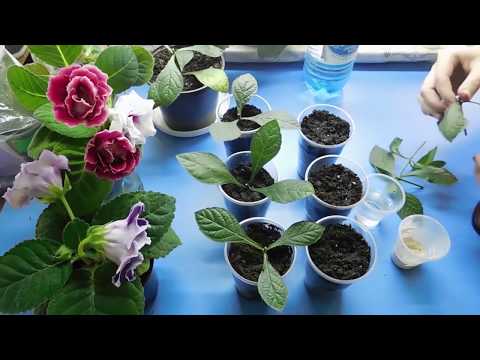

Watch this video on YouTube
Pests and diseases of clerodendrum
Pests
Insects such as whiteflies and spider mites are most commonly harmed by the clerodendrum. As a rule, whitefly can be found on the lower surface of the leaf plates, and on the front side of the leaf, due to the presence of pest feces, a shiny plaque appears, which is called honeydew or honeydew. If a spider mite settles on a flower, then you will not be able to see it with the naked eye. White dots that appear on the seamy surface of the foliage will tell you about its presence on the plant, and you can also find a very thin web on the bush. To get rid of both the tick and the whitefly, clerodendrum can be treated with an insecticidal preparation. For example, take 1 liter of water and combine it with one ampoule of Actellik, treat the plant with the resulting solution. If necessary, you can carry out four sprays with a break of three days.
Clerodendrum does not bloom
Often, beginners when growing clerodendrum are faced with such a problem as the lack of flowering. Moreover, the cause of this problem is often very simple and at the same time unexpected. If you understand that clerodendrum refuses to bloom due to improper care, and try to fix everything, then soon all problems will be resolved by themselves. Most often, Clerodendrum does not bloom if it was in unsuitable conditions during the winter.
Can Clerodendrum be made to bloom? In order to see the beautiful flowering of such a plant in spring, you need to keep it cool in winter. Immediately after the bush has faded, watering is gradually reduced, and it is also removed to a rather cold place (the air temperature is not higher than 15 degrees). Best of all, the culture hibernates at a temperature of about 12 degrees, while watering should be rare and scarce, but the earthen coma cannot be completely dried out.
The dormant period lasts about 6–8 weeks, during which time the plant has time to rest well and stock up on strength for a new growing season and flowering. After the young shoots appear at the bush, gradually resume normal watering, cut it off and, if necessary, transplant it. Put the clerodendrum in its permanent place and start feeding it regularly again.
Remember to keep your potted soil fertile at all times. Often the bush refuses to bloom even if it has not been transplanted for a very long time. And the plant may not bloom due to poor lighting, in this case, already formed buds sometimes crumble.
Clerodendrum turns yellow
In the event that yellowing of the foliage is observed in the spring-summer period, then this may be due to rather rare and scarce watering. To fix this, water more often or pour more water into the pot and remember that there must be some liquid in the pan all the time.
The appearance of yellow spots on the foliage may be associated with the development of chlorosis. In this case, an iron-containing agent can help clerodendrum.
Flying around foliage
In the event that the leaves fall in the cold season, then this can be a completely natural process. This can be observed in all deciduous plants. As a rule, the foliage gradually turns yellow and flies around during the autumn-winter period. But if the foliage is flying around in the warm season, then most likely the flower is not properly looked after or it needs to be moved to another place.


Watch this video on YouTube
Types of clerodendrum with photos and names
Thomson's Clerodendrum (Clerodendrum thomsoniae)
This type is most popular among flower growers. It is represented by a deciduous ligneous vine, which has thin, smooth stems. Large dense leaf plates of dark green color are entire, on their surface, veins are clearly visible. The length of the leaves is about 12 centimeters, and their shape is oblong-ovate, pointed. On the front surface of the foliage there are specks of irregular shape, which can be painted in darker and lighter shades. Swollen white flowers have a red corolla; they are part of the axillary loose brushes. In indoor conditions, this species is characterized by rapid growth, it is propagated exclusively by cuttings, and flowering lasts from March to June.
Clerodendrum splendens
This evergreen shrub has curly stems that adorn the leaf plates of an almost round shape with a heart-shaped base, they have a wavy edge and an oblong pointed tip. The plates reach 8 centimeters long and 6 centimeters wide. Short axillary inflorescences of corymbose or racemose form consist of scarlet-red flowers. Flowering lasts almost throughout the year.
Clerodendrum philippinum
This species differs from the rest in that it has a pungent, but pleasant vanilla-jasmine scent, in the evening it becomes even stronger. This species is grown by flower growers relatively rarely, although it is quite easy to care for it, since it is undemanding to care for. Already in the second year of life, spectacular whitish-pink inflorescences appear on the bush, having a diameter of about 20 centimeters, they include pink-shaped flowers, reaching from 20 to 30 mm in diameter. They look very impressive against the background of dark green wide leaf plates.
Clerodendrum ugandense
This evergreen vine is fast growing, its length can reach 200 cm. The shape of the dark green leaf plates is broad-lanceolate. The terminal few-flowered loose inflorescences consist of flowers that are very similar to butterflies, thanks to the blue filamentary stamens, resembling antennae. The lateral as well as the upper petals are blue in color, while the barely distinguishable lower petal is colored purple or bluish-lilac. With the help of pruning, this type can be shaped into a tree or bush.
Fragrant Clerodendrum (Clerodendrum fragrans)
This shrub is evergreen and reaches a height of about 200 cm. There is pubescence on the surface of the stems. Broadly ovate leaf plates are also pubescent, they reach up to 20 centimeters in length and have deep denticles along the edge. Lush corymbose apical inflorescences, reaching about 80 mm in diameter, consist of double or simple white flowers with a pinkish tinge on the outside, their smell is similar to citrus fruits and violets. Flowering lasts almost all year round.
Wallich's Clerodendrum, or Prospero's Clerodendrum
This type is also called the bride's veil, or Cleopatra's tears, or the bride's veil. It blooms very luxuriantly with snow-white inflorescences, which consist of flowers of an unusual very refined shape. The bush is compact and very graceful, its stems are tetrahedral, and they are decorated with lanceolate leaf plates of a dark green color, which reach 50–80 mm in length, with a wavy edge. This species differs from the others in its high demands on growing conditions. For normal growth and development, he needs high humidity and a special daylight hours.
Clerodendrum speciosum
Such an evergreen shrub has four-sided stems that reach a height of 3 meters. Large glossy heart-shaped leaf plates are located on long petioles of a reddish hue, there are villi on the surface. The apical panicle inflorescences consist of purple flowers with dark red corollas. Lush bloom occurs in June – September.


Watch this video on YouTube


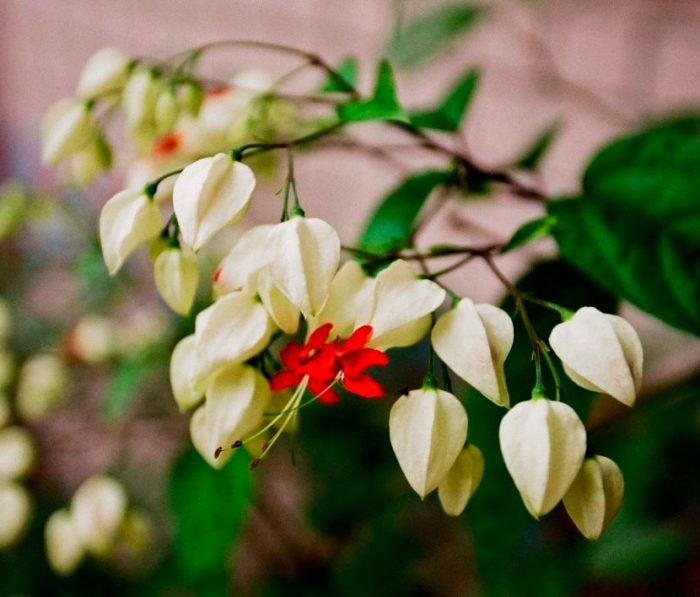
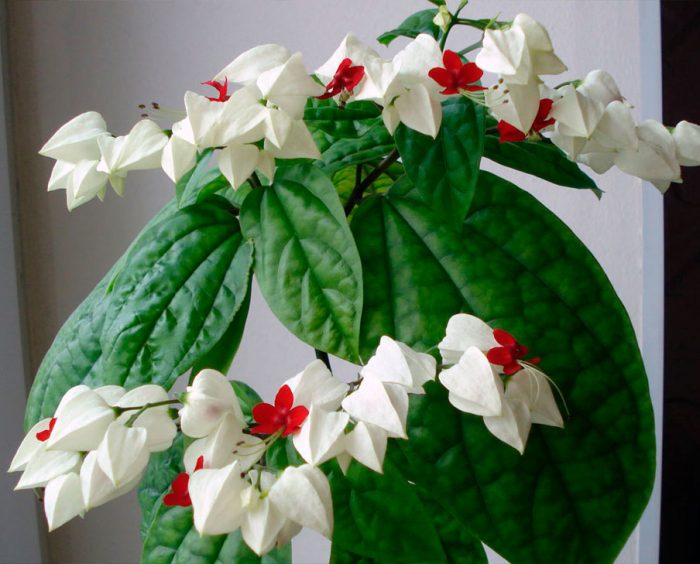
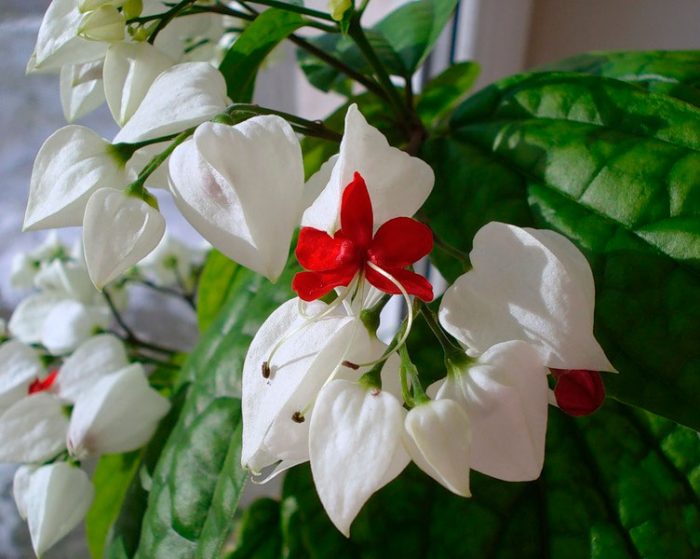
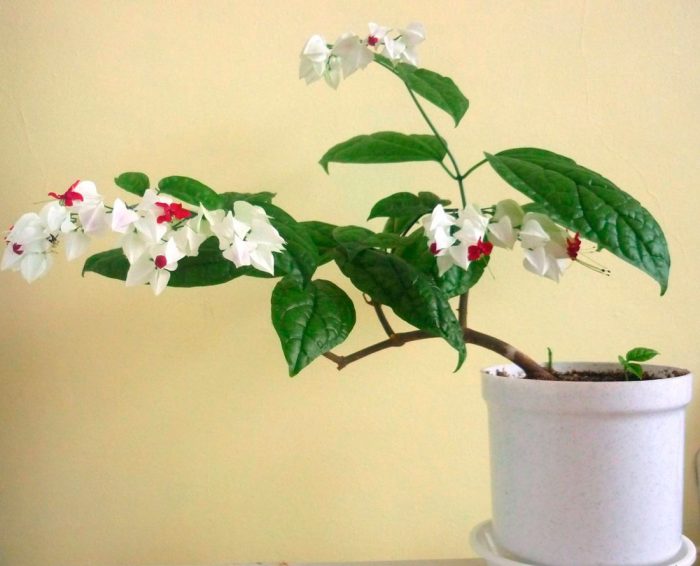
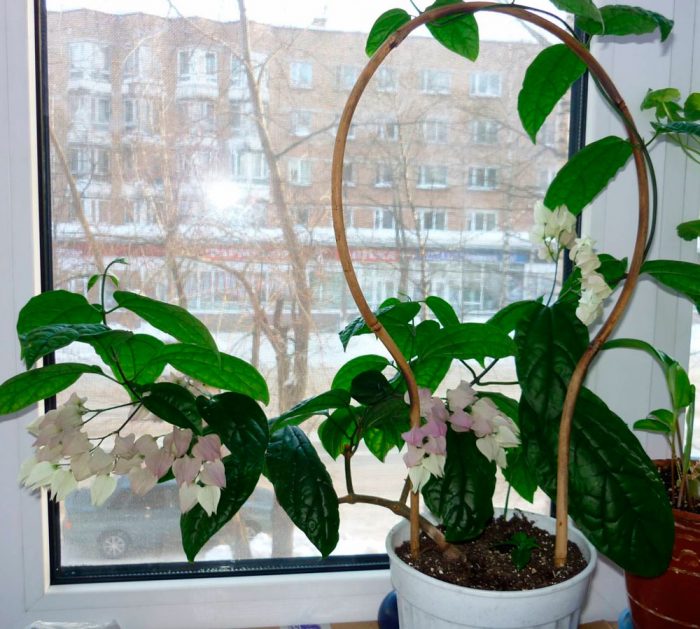
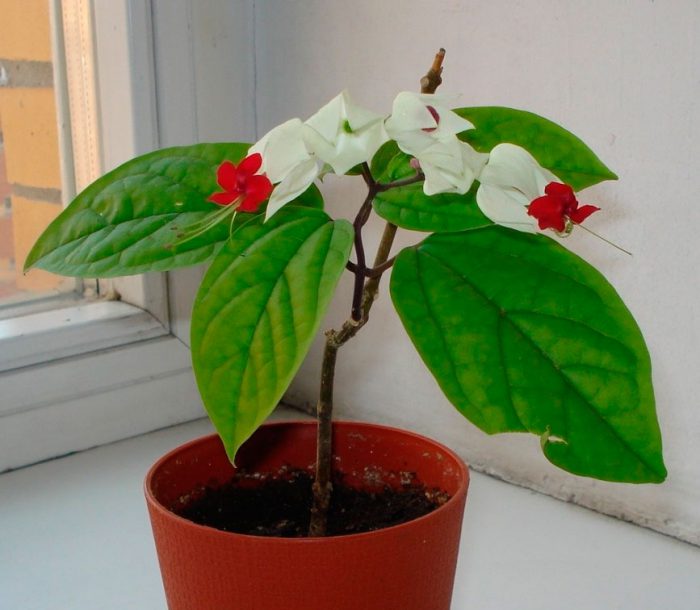
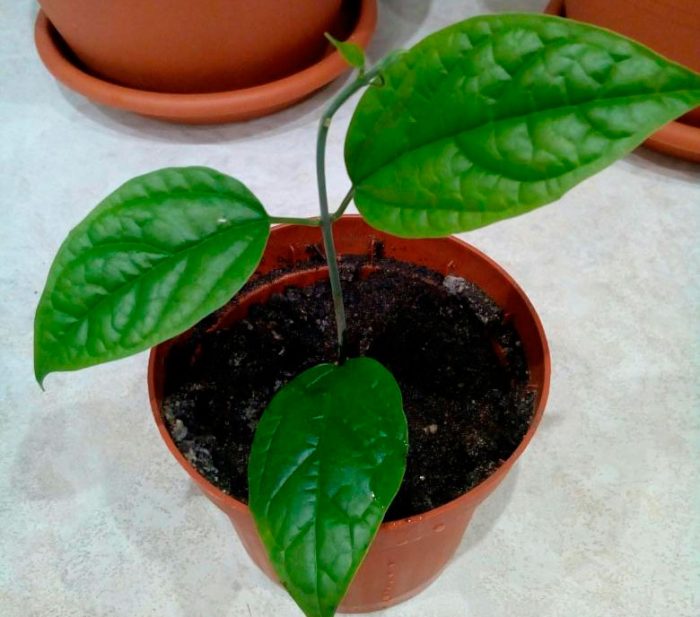
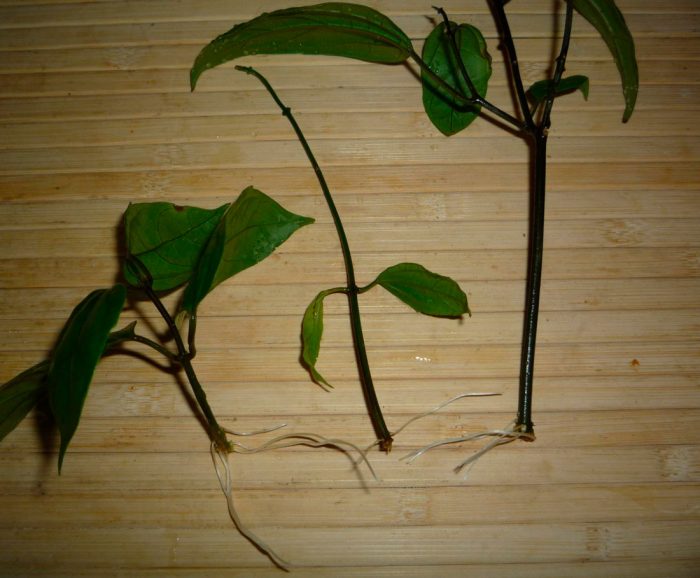
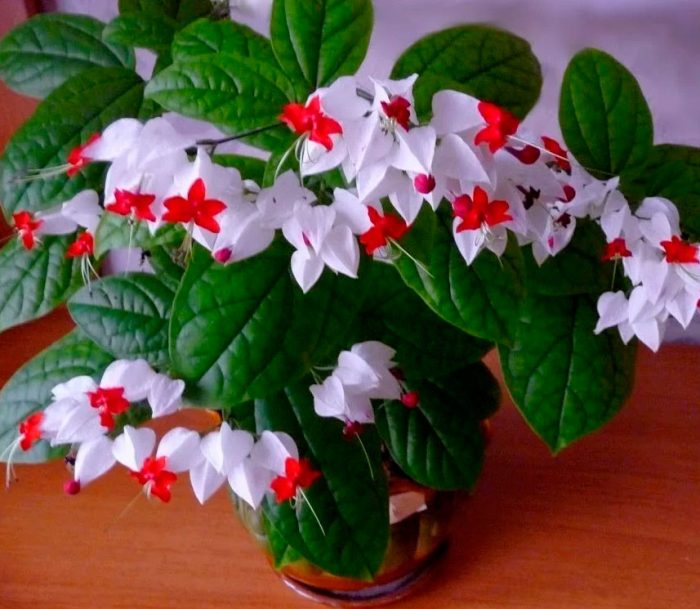
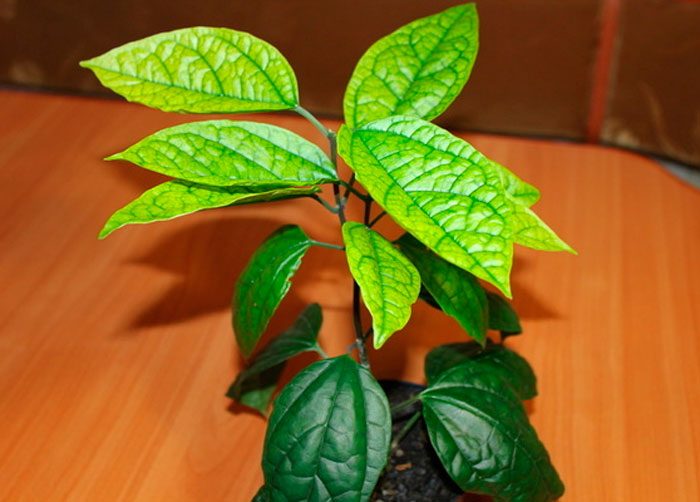
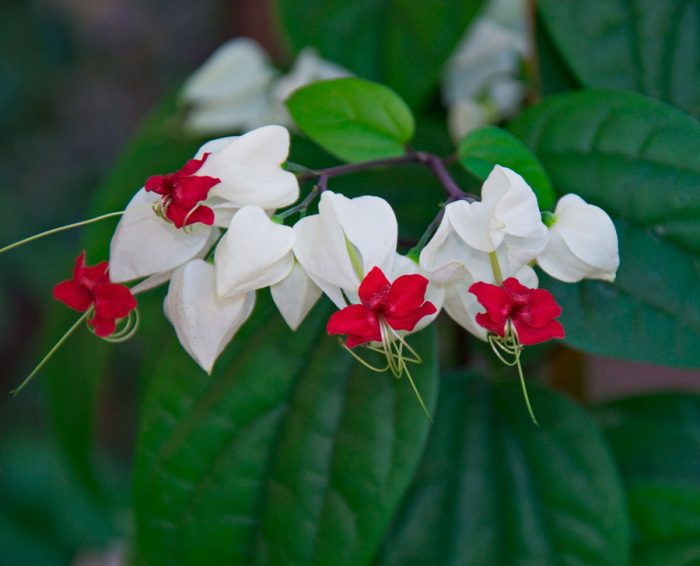
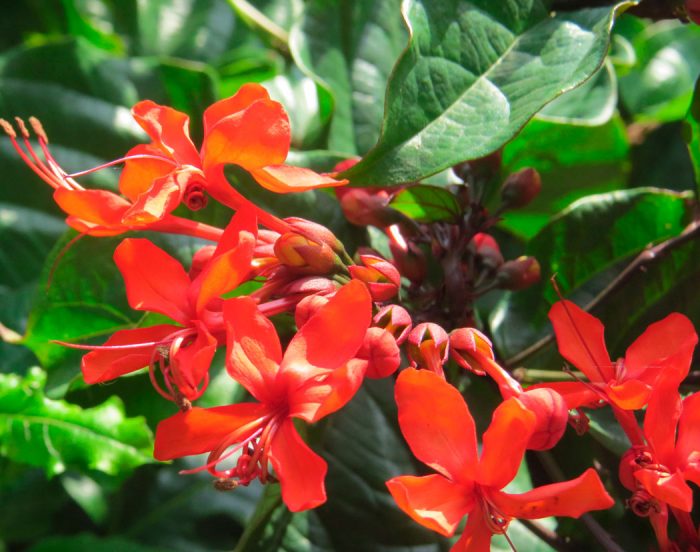
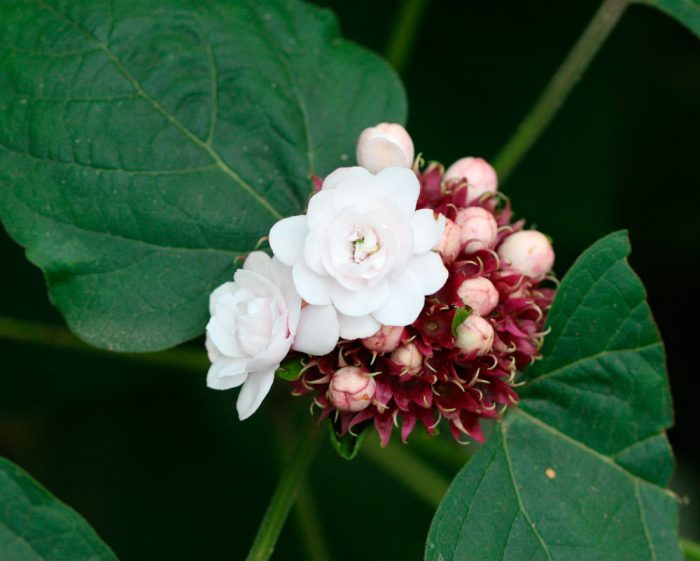
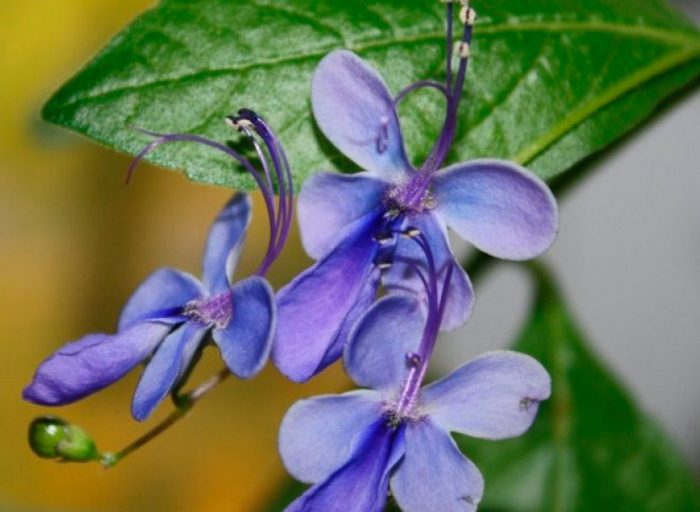
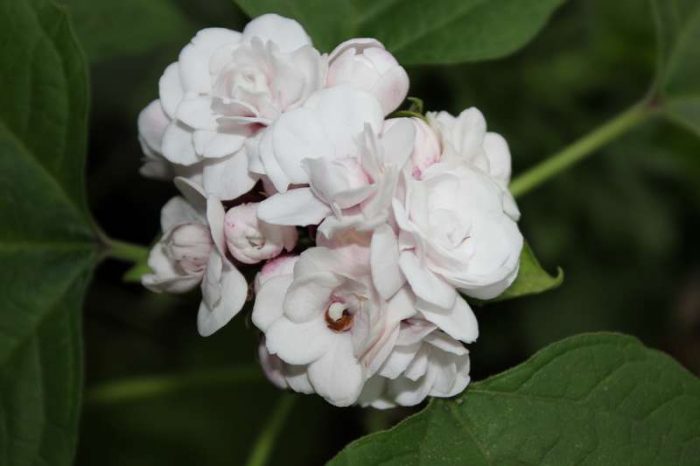
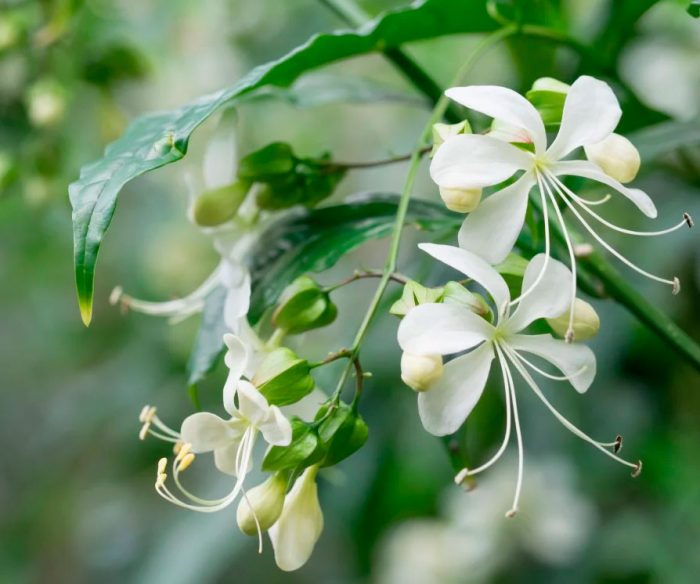
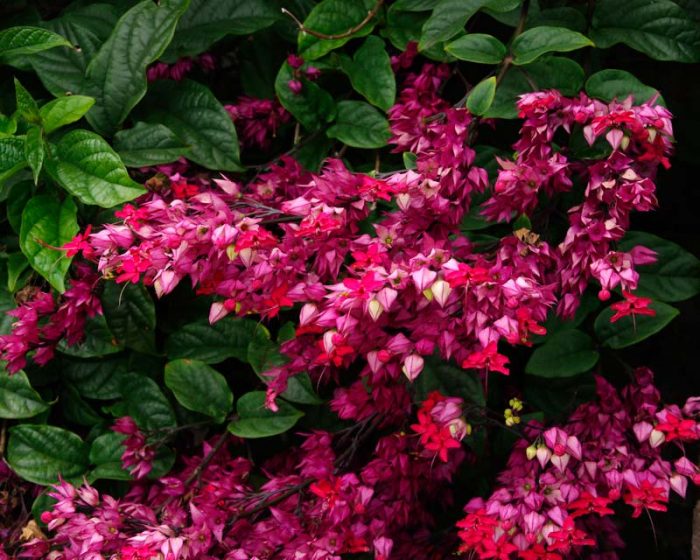

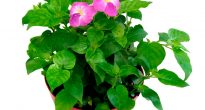
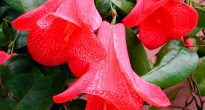
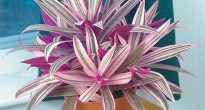
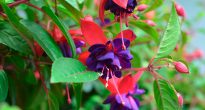

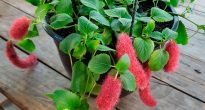
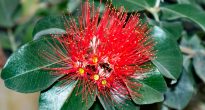


Thank you very much for the carefully prepared and convenient information.
It helped a lot to figure out what my new friend needs.
Keradendron.
Thanks for the detailed information. The flower passed on from friends and I only recently found out what it is called. Now it is clear how to take care of him.
And on my clerodendrum I got some kind of ailment, tell me how to save the plant. On the inside of the leaf, some kind of dew droplets form, then in this place the foliage dries up and black spores appear.
Where to buy this beautiful flower?
Thanks for the information, my husband brought a twig, planted it, bloomed in the spring after transplantation, but I don’t know what kind of animal he is. now we will make friends with him.